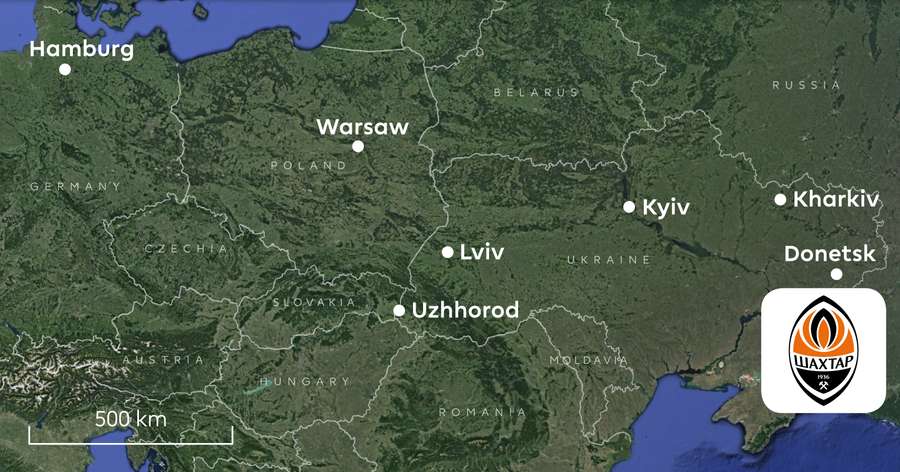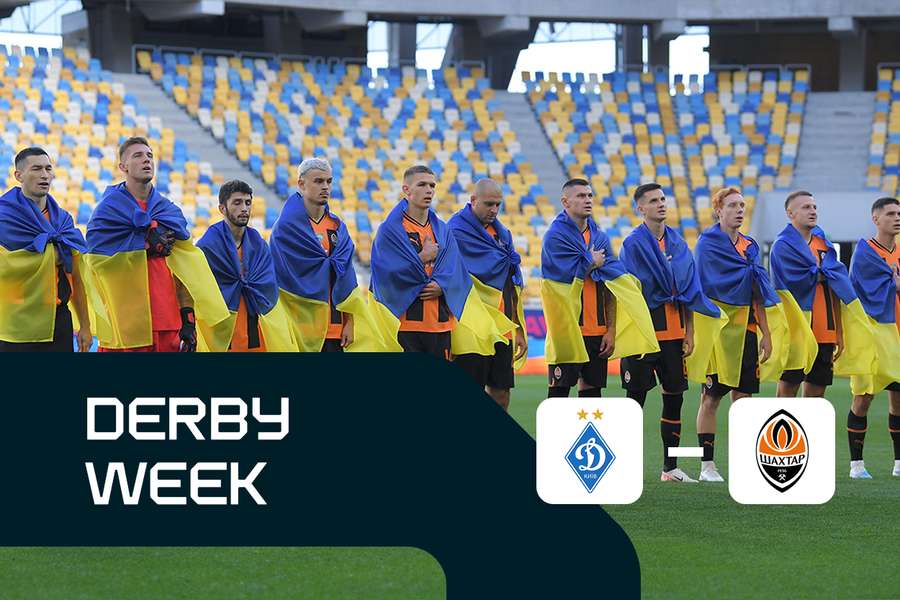Alongside the battle between the two football giants, it is also a battle between the capital Kyiv and the industrial region in the east of the country - Donbas. Moreover, since 2014, Shakhtar haven't been able to play in their beautiful stadium due to the war in the region, only adding further complexity to this rivalry.
The Soviet brand
Dynamo Kyiv was founded in 1927 as one of the branches of the national 'all-Union' sports association of the former Soviet Union. This organization, which was given the dynamic and politically neutral name 'Dynamo,' operated within the country under the authority and control of the KGB (Soviet State Security Committee).
In addition to the name, the club adopted another symbolism of the institution - the logo in the shape of the letter 'D,' which in written Cyrillic looks very similar to the Latin alphabet. Which was also one of the important aspects for these Soviet brands to be able to break through elsewhere in the world.
Dynamo's emblem, also typically light blue (often combined with yellow), is well known to sports fans thanks to other (post-)Soviet clubs. In fact, similar clubs were founded in the USSR - Dynamo Moscow, Dinamo Tbilisi, Dinamo Minsk - and in other so-called 'Eastern Bloc' countries. That is to say, where communist parties with strong links to Moscow and the Soviet regime were in power in the second half of the 20th century.
The Croatian club Dinamo Zagreb or the (East) German Dynamo Dresden are examples of still very famous teams, while in the Czech Republic, the same name is used by Ceske Budejovice.
Players of such clubs were not officially employed as athletes in the Soviet Union but were part of the army. All organisations under this brand (and others based on a similar principle) in the Soviet Union and other Eastern Bloc countries operated in this way.
The club of the Stakhanovites
The club known today as 'Shakhtar' was formed in Donetsk in 1936 by the merger of two units, coincidentally both named Dynamo - Dynamo Horlivka and Dynamo Stalino (Stalino was the pro-Soviet name for Donetsk until 1961). The result of the merger was given the name 'Stalino,' which was related to the propagandistic Stakhanovite movement that was on the rise at the time of its founding.
The naming of the movement and the football team was inspired by Alexei Stakhanov, a miner working in the Donetsk region. He was famous for his incredible work performance, which exceeded the mandatory labour standards. During one shift, he reportedly managed to exceed the set limit by up to 14 times. The ruling establishment created a cult of personality out of Stakhanov, presenting him as a model for the working people. Members of the Stakhanov movement, in pursuit of extraordinary work performance and praise, often failed to observe safety precautions and used specially adapted work equipment.
In 1946, the name of the club was changed to 'Shakhtar,' which translates as 'miner.' Like Dynamo and other organizations representing some of the professions of socialist society (for example, Lokomotiv, a sports association of railway workers), Shakhtar was one of the USSR-wide unions, in this case, specifically uniting miners. The Donetsk club is from a huge mining and industrial area of the Donbas (named after the river Don and the term for a coal basin). Other major footballing powerhouses with the name Shakhtar include teams from Karaganda in Kazakhstan and Salihorsk in Belarus.
A Soviet past with a European future
In the days of the Soviet Union, Dynamo Kyiv was clearly the best Ukrainian side. It was among the absolute top of the Soviet competition and even the best club in the history of the Soviet league in terms of titles. It won a total of 13 USSR championship titles. Therefore, it became a thorn in the side of the ruling Moscow elite and thus a great rival of Moscow's big clubs Spartak (12 championships), Dynamo (11) and CSKA (seven).
Kyiv's footballers have managed to succeed even on a European scale. In 1975, they won the UEFA Cup and, 11 years later, the Cup Winners' Cup. In the imaginary ranking of Ukrainian clubs within the framework of Soviet football, behind them as unequivocal kings were the predecessors of today's teams FC Dnipro and Zorya Luhansk. For most of the time, Shakhtar were an average team in the Soviet League.
Even after the collapse of the USSR and the creation of an independent Ukraine, the local league continued to have the same leaders. Between 1993 and 2001, Dynamo won the league nine times in a row and also did well in European cups. One memorable example is Andriy Shevchenko's hat-trick against Barcelona in a 4-0 win at Camp Nou.
However, during the 1990s, the power of the mining club from the east of Ukraine began to rise. It culminated in winning their first title in 2002 and it was not an isolated success. Shakhtar have never finished worse than second in the Ukrainian league since. With Dynamo regularly in the elite two, a huge rivalry was naturally born at the beginning of the 21st century, now known as the 'Classic Derby.'
A European clash
In the 2008/09 season, the two rivals also faced each other on the European stage, in the UEFA Cup semi-finals. The opening match in Kyiv ended 1-1, and the second leg in Donetsk was heading towards the same result but it was the home side's 89th-minute goal that finally decided the game. Shakhtar then crowned their success by winning the final against Werder Bremen, becoming the first (and so far only) club in the history of independent Ukraine to triumph in a European Cup.
The whole country is now being negatively affected by the war waged by Russia. The eastern region has been a target of conflict for much longer, with fighting in the Donbas starting as early as 2014, and Shakhtar has been without a home since then. Its state-of-the-art arena for more than 50,000 spectators, which opened in 2009 and also hosted 2012 European Championship matches, unfortunately only had football for five years.

Since then, Shakhtar has called on a number of cities in Ukraine and abroad for its home games. Arena Lviv in western Ukraine now serves as its refuge. They have also played in Kharkiv, Uzhhorod, and even at the Olympic Stadium in Kyiv, where their biggest rival play. Thus the Classic Derby is turning into a city derby only in quotes.
Last season, the black and orange side played European matches at the Stadion Wojska Polskiego in Warsaw, and this season they are playing home games in the Champions League at the Volksparkstadion in Hamburg. Despite having to seek refuge far from Donetsk, they have consistently maintained an incredibly high level of performance. After the 2021/22 Ukrainian league season was cancelled due to the war, Shakhtar managed to win another championship title in 2023. The last pre-war champion was Dynamo Kyiv.
Follow the next Classic Derby this Friday from 16:00 CET with Flashscore.
Next derby of the week
Thursday, November 2nd
Belarus - Vysshaya Liga
Belarusian Clasico
Dinamo Minsk from the Belarusian capital ruled local football during the USSR era and in the 1990s. BATE, a club from Borisov, a small town near Minsk, sponsored by Borisov Automobile and Tractor Electrical Parts (BATE), is the successor heavyweight.
Romania - Cupa Romaniei
Cluj Derby
Cluj is the third largest city in Romania and the capital of the Transylvania region. It is home to two traditional clubs, CFR Cluj and Universitatea Cluj. Their last derby in the league was won by CFR footballers in August after a 4-3 shootout. Now the two rivals will also clash in the national cup.
Austria - OFB Cup
Graz Derby
The Austrian Cup will see a battle for Grazer Grazer. Grazer AK, currently in the second league, last faced Sturm in the top flight in 2007. That last derby, however, is a match from 2022, when the two teams also met in the cup. Sturm won 1-0.
Saturday, November 4th
Germany - Bundesliga
Borussia Dortmund - Bayern Munich
Der Klassiker (The Classic)
The clash between Borussia Dortmund and Bayern Munich is the biggest match in German football. Bayern have won 33 titles, Borussia are third in the historical tables (eight). 1. FC Nuremberg has one more triumph (but last won the league in 1968 and is currently in the second Bundesliga).
Brazil - Serie A
Classico das Multidoes (Clasico of the Crowds)
The biggest derby in the Brazilian city of Belo Horizonte is the match between Atletico Mineiro and Cruzeiro. However, Atletico's bigger rival used to be America FC. This match has traditionally attracted the most spectators, which is why it is nicknamed the 'Clasico of Crowds' (which is also a common name for other derbies elsewhere in Brazil).
Czech Republic - Fortuna Liga
Little Prague derby
Sparta and Slavia are the biggest rivals within Prague and the whole Czech Republic. Fights between other clubs from the capital city and one of the two big Prague 'S' clubs or between each other are referred to as 'small Prague derbies.' Bohemians and Sparta will face each other twice in a week - first in the cup (on Wednesday), then in the league at the weekend.
Sunday, November 5th
Czech Republic - Fortuna Liga
Silesian derby
Silesia is one of three historical regions within the Czech Republic (the other two being Bohemia and Moravia). In football, it is represented mainly by three clubs - Banik Ostrava, Karvina and Opava. Between 2018 and 2021, all of them were even part of the top Czech competition.
Germany - 2. Bundesliga
Hannover 96 - Eintracht Braunschweig
Niedersachsen Derby (Lower Saxony Derby)
Hannover and Braunschweig are located 70 km apart in the state of Lower Saxony in northern Germany. The top clubs from both cities have been competing against each other most recently in the second Bundesliga. The current season is no exception. Braunschweig are currently last in the table with just five points.
Bolivia - Division Profesional
Club Blooming - Oriente Petrolero
Clasico cruceno/Derby o Santa Cruz de la Sierra
The city of Santa Cruz de la Sierra is the second largest in Bolivia. It is home to more than two million inhabitants and also to four premier league teams: Blooming Club, Oriente Petrolero, Real Santa Cruz and Royal Pari. Blooming and Oriente are the strongest of the two, and so their match is also the city's biggest derby.
Monday, November 6th
Brazil - Serie A
Classico da Amizade (Friendly Clasico)
Derbies are often very tense matches in Brazil. However, the duel between Vasco da Gama and Botafogo, two clubs from Rio de Janeiro, is an exception. Even though they are rivals, their jousting and the overall relationship between their fans usually does not cause any problems. This is a 'friendly clasico.'
Tuesday, November 7th
Northern Ireland - League Cup
Ballymena United - Coleraine FC
A26 derby
The derby between Ballymena United and Coleraine FC is named after the A26 motorway which connects the two towns in the north of Northern Ireland. The two sides have already met twice in the current season. The first derby was won by Coleraine, the second by Ballymena. Now the rivals face each other in the League Cup semi-finals.
Big Two derby
The League Cup semi-finals in Northern Ireland will also bring the country's biggest derby. The so-called 'Big Two' from Belfast - Linfield and Glentoran - will face each other. Both are Northern Ireland's strongest and most successful clubs. Linfield have won 56 championships, and Glentoran have won the title 23 times.

